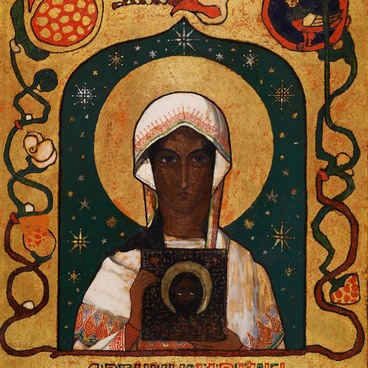The iconography of the Last Judgement developed on the basis of texts of the Biblical Apocalypse, prophecies of the Old Testament and parables of the Gospels. According to the legend, when Jesus Christ comes to the earth again, all the people who ever used to live in this world will rise from the dead and will be answerable to him for their actions. The sinners will get to hell, while the righteous will go to heaven.
Icons of the Last Judgement were widespread in Byzantium in the 10th-11th centuries, while in Russia such icons started to be painted shortly thereafter. One of the oldest Russian images with this subject can be found in Veliky Novgorod: these are fresco paintings on the walls of Nikolo-Dvorishchensky Cathedral. Those were painted in early 12th century. The earliest Russian icon was painted later: in the 15th century. It is kept in the Assumption Cathedral, the main cathedral of the Moscow Kremlin.
The Last Judgement is one of the most complex icons from the standpoint of composition. It consists of several segments, each of them having a lot of figures. In the center of the top segment, the Holy Trinity was usually painted in a medallion or a round aureole, next to the Trinity there usually was an army of angels and inhabitants of New Jerusalem who were facing unending bliss. In the second segment, Jesus Christ the Pantocrator as the King of Kings was painted in a shining mandorla: a round aureole encompassing the whole body. Christ was being addressed by the Virgin Mary and St. John the Baptist in pray for humankind. That composition is also called the Deisis. In the center of the third segment one can see weighing scales to weigh all good and evil deeds of every human. If the evil deeds overweigh, the sinner is thrown to hell. The hell is painted in the bottom segment of the icon. There icon painters showed the Devil with Judas’ soul in his hands, a fiery dragon, scenes of torments of drunks, murderers, fornicators and other sinners.
Visually, the icon could be divided into two parts. In the left part, i.e. to the right of Jesus Christ, there were saints, righteous and their souls that were accepted to heaven. In the right part, painters usually showed demons, sinners and fallen angels descending to hell.
Icons of the Last Judgement were widespread in Byzantium in the 10th-11th centuries, while in Russia such icons started to be painted shortly thereafter. One of the oldest Russian images with this subject can be found in Veliky Novgorod: these are fresco paintings on the walls of Nikolo-Dvorishchensky Cathedral. Those were painted in early 12th century. The earliest Russian icon was painted later: in the 15th century. It is kept in the Assumption Cathedral, the main cathedral of the Moscow Kremlin.
The Last Judgement is one of the most complex icons from the standpoint of composition. It consists of several segments, each of them having a lot of figures. In the center of the top segment, the Holy Trinity was usually painted in a medallion or a round aureole, next to the Trinity there usually was an army of angels and inhabitants of New Jerusalem who were facing unending bliss. In the second segment, Jesus Christ the Pantocrator as the King of Kings was painted in a shining mandorla: a round aureole encompassing the whole body. Christ was being addressed by the Virgin Mary and St. John the Baptist in pray for humankind. That composition is also called the Deisis. In the center of the third segment one can see weighing scales to weigh all good and evil deeds of every human. If the evil deeds overweigh, the sinner is thrown to hell. The hell is painted in the bottom segment of the icon. There icon painters showed the Devil with Judas’ soul in his hands, a fiery dragon, scenes of torments of drunks, murderers, fornicators and other sinners.
Visually, the icon could be divided into two parts. In the left part, i.e. to the right of Jesus Christ, there were saints, righteous and their souls that were accepted to heaven. In the right part, painters usually showed demons, sinners and fallen angels descending to hell.

